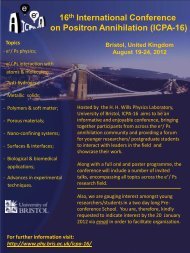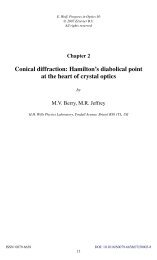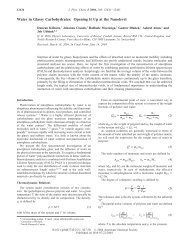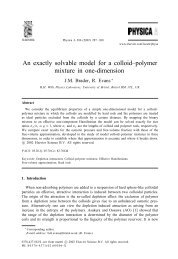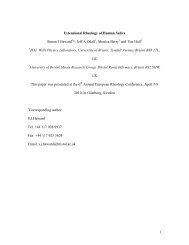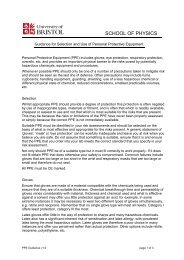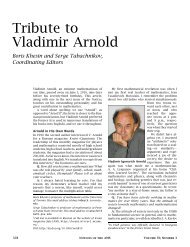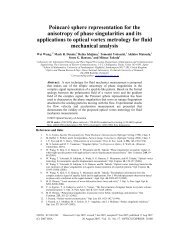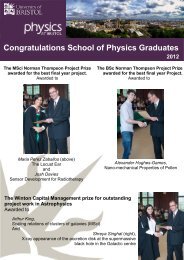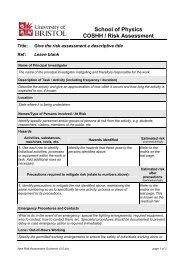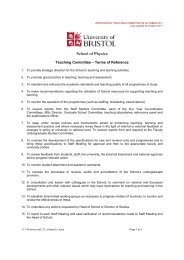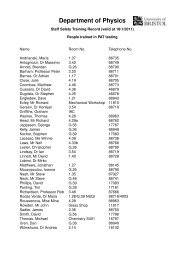Why isn't nature more non-local? - Physics
Why isn't nature more non-local? - Physics
Why isn't nature more non-local? - Physics
You also want an ePaper? Increase the reach of your titles
YUMPU automatically turns print PDFs into web optimized ePapers that Google loves.
NEWS & VIEWS<br />
QUANTUM MECHANICS<br />
<strong>Why</strong> isn’t <strong>nature</strong> <strong>more</strong> <strong>non</strong>-<strong>local</strong>?<br />
Many predictions and consequences of quantum mechanics defy intuition. New<br />
insights into the limits of communication between spatially separated parties<br />
could bring us closer to grasping the <strong>nature</strong> of the quantum world.<br />
SANDU POPESCU<br />
is in the H.H. Wills <strong>Physics</strong> Laboratory, University of Bristol,<br />
Tyndall Avenue, Bristol BS8 1TL, and the Hewlett-Packard<br />
Laboratories, Stoke Gifford, Bristol BS12 6QZ, UK.<br />
e-mail: S.Popescu@bristol.ac.uk<br />
Microscopic particles — molecules, atoms,<br />
subatomic particles and so on — behave<br />
very strangely and very differently from<br />
ordinary objects like footballs, pebbles and chairs.<br />
We have a very good theory to explain their<br />
behaviour: quantum mechanics. But all is not good.<br />
More than seven decades after the discovery of<br />
quantum mechanics, it is fair to say that we lack an<br />
intuitive and deep understanding of it — witness<br />
the many puzzles and surprises that are discovered<br />
routinely. It is still an open question why quantum<br />
behaviour is what it is. But Brassard et al., reporting<br />
in Physical Review Letters 1 , take a significant step in<br />
unveiling the mystery.<br />
One of the strangest things microscopic particles<br />
can do is to yield <strong>non</strong>-<strong>local</strong> correlations. Suppose two<br />
experimentalists, Alice and Bob, are situated in two<br />
remote labs, say on two different planets (Fig. 1), and<br />
perform measurements on particles that come from a<br />
common source and are in an ‘entangled’ state. Even<br />
if the measurements are performed simultaneously,<br />
so that no information from Alice can reach Bob<br />
before his measurement is finished, and vice versa,<br />
the results of their measurements can be correlated.<br />
This is no surprise — after all, the particles came from<br />
the same source. What is astonishing, however, is<br />
that they are correlated in such a way that if we try to<br />
simulate the correlations with macroscopic systems,<br />
a consistent result can only be obtained if Alice and<br />
Bob’s systems communicate with each other during<br />
the measurements. However, due to the timing of the<br />
experiment, this communication would have to be<br />
faster than light.<br />
That <strong>non</strong>-<strong>local</strong> correlations can exist at all and<br />
do not lead immediately to a conflict with Einstein’s<br />
relativity is possible only due to the fact that the<br />
results of measurements on microscopic particles<br />
are probabilistic. Non-<strong>local</strong>ity is thus related to the<br />
most fundamental aspect of quantum mechanics,<br />
<strong>non</strong>-determinism.<br />
This led Yakir Aharonov (personal<br />
communication) and Shimony 2 independently to<br />
Figure 1 Keep communication simple. How much information does Earth-bound Bob have to send to<br />
extra-terrestrial Alice in order to fi x a date?<br />
suggest that <strong>non</strong>-<strong>local</strong>ity might be the basic element<br />
of quantum mechanics, the reason why quantum<br />
mechanics is what it is. Following their suggestion,<br />
Popescu and Rohrlich 3 asked whether quantum<br />
mechanics is the only theory that can combine<br />
relativity, that is, finite speed for signal propagation,<br />
with <strong>non</strong>-<strong>local</strong>ity. Surprisingly, they found that the<br />
range of <strong>non</strong>-<strong>local</strong> correlations that are compatible<br />
with <strong>non</strong>-superluminal signalling is larger than the<br />
ones that can be generated by quantum mechanics.<br />
But are there such ‘super-quantum’ correlations in<br />
<strong>nature</strong>, they asked, and, if not, why not? And what<br />
could be a new axiom to uniquely determine quantum<br />
mechanics, in addition to obeying relativity and the<br />
existence of <strong>non</strong>-<strong>local</strong>ity?<br />
Let us return to Alice and Bob. One day Alice<br />
and Bob decide to meet each other for the first<br />
A I POPESCU<br />
<strong>nature</strong> physics | VOL 2 | AUGUST 2006 | www.<strong>nature</strong>.com/<strong>nature</strong>physics 507<br />
©2006 Nature Publishing Group
NEWS & VIEWS<br />
time. But they are so busy that finding even one<br />
good day when both are free is quite daunting.<br />
To make a boring task <strong>more</strong> fun, they decide to<br />
play a little game. Rather than trying to find a<br />
good day directly, they first want to know whether<br />
the number of good days available this year is<br />
even or odd. Alice sending her entire schedule to<br />
Bob would do the job, but this involves a lot of<br />
communication. And Bob learns <strong>more</strong> than what<br />
he wanted; he finds out not only if the total number<br />
of good days is even or odd, but also exactly which<br />
the good days are. Could they do better, with less<br />
communication? In the end, all Alice and Bob want<br />
to find out is a single bit of information — whether<br />
the total number N is ‘even’ or ‘odd’ — so why send<br />
N bits, a ‘free’ or ‘busy’ day for each of the N days<br />
of the year? This is an example of a ‘communication<br />
complexity’ problem.<br />
Unfortunately for Alice and Bob, computer<br />
scientists have proved that sending the entire<br />
calendar is a necessity. There is no better way. But<br />
what if Alice and Bob share pairs of entangled<br />
quantum particles? After all, the particles have<br />
<strong>non</strong>-<strong>local</strong> correlations — perhaps Alice and Bob<br />
could use them. This isn’t as crazy as it seems<br />
at first sight: Cleve and Buhrman 4 found that<br />
<strong>non</strong>-<strong>local</strong> correlations can indeed help in some<br />
communication problems. However, it has also been<br />
shown by Cleve et al. 5 that quantum mechanical<br />
correlations cannot help Alice and Bob with their<br />
‘even versus odd’ problem.<br />
That quantum mechanics cannot help is<br />
unfortunate indeed, because Alice and Bob’s<br />
calendar problem is not just an idle game. In fact,<br />
every single communication complexity problem<br />
in which Alice and Bob want to learn just one bit<br />
of information can be reduced to this particular<br />
problem (technically called the ‘inner product’).<br />
Thus, if the inner product problem could be solved<br />
by communicating a single bit, than any other<br />
problem can be solved by a single bit too.<br />
A breakthrough came when van Dam 6,7 showed<br />
that particles that could yield a particular type of<br />
super-quantum <strong>non</strong>-<strong>local</strong> correlations (so-called<br />
‘maximally <strong>non</strong>-<strong>local</strong>’ correlations) can help<br />
solve the inner product problem with a single bit<br />
of communication. These maximally <strong>non</strong>-<strong>local</strong><br />
correlations would then render all communication<br />
complexity problems trivial. A world with such<br />
correlations would be very strange indeed:<br />
all communication complexity tasks could be<br />
performed by sending one bit.<br />
The maximal <strong>non</strong>-<strong>local</strong> correlation, however,<br />
is a very particular one. And here, finally, come<br />
Brassard and his colleagues 1 . They suggest, and make<br />
significant steps towards proving, that not only this<br />
maximal correlation, but all correlations stronger<br />
than those provided by quantum mechanics may<br />
render communication complexity trivial.<br />
So, according to Brassard et al. the reason why<br />
quantum mechanics is not <strong>more</strong> <strong>non</strong>-<strong>local</strong> than<br />
it is, is because otherwise it is very likely that all<br />
communication complexity would be trivial. But why<br />
wouldn’t <strong>nature</strong> allow all communication to be trivial?<br />
Or does it? The search is still on.<br />
REFERENCES<br />
1. Brassard, G. et al. Phys. Rev. Lett. 96, 250401 (2006).<br />
2. Shimony, A. in Proc. Int. Symp. Foundations of Quantum Mechanics 225<br />
(Physical Society of Japan, Tokyo, 1983).<br />
3. Popescu, S. & Rohrlich, D. Found. Phys. 24, 379–385 (1994).<br />
4. Cleve, R. & Buhrman, H. Phys. Rev. A 56, 1201–1204 (1997).<br />
5. Cleve, R., van Dam, W., Nielsen, M. & Tapp, A. Lect. Notes Comput. Sci. 1509,<br />
61–74 (1999).<br />
6. van Dam, W. Thesis, Univ. Oxford (1999).<br />
7. van Dam, W. Preprint at (2005).<br />
508 <strong>nature</strong> physics | VOL 2 | AUGUST 2006 | www.<strong>nature</strong>.com/<strong>nature</strong>physics<br />
©2006 Nature Publishing Group



